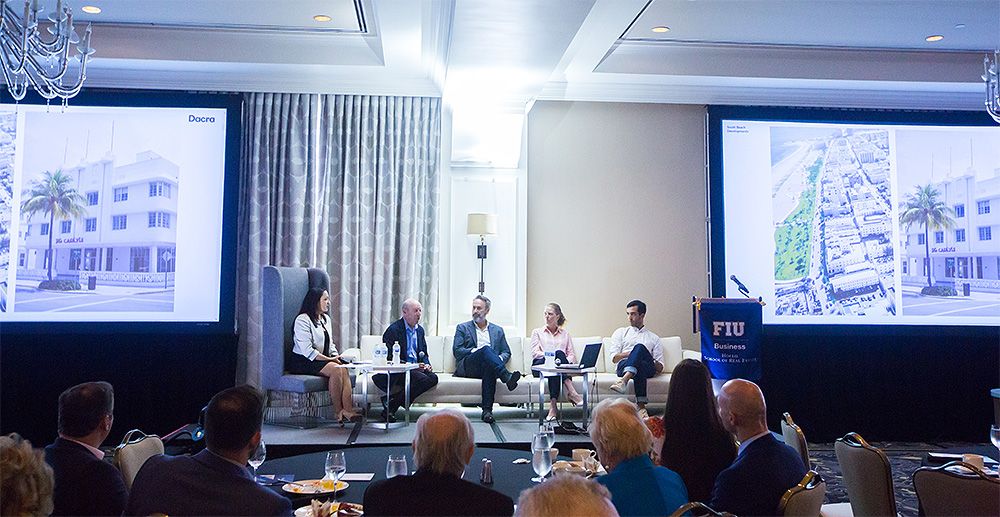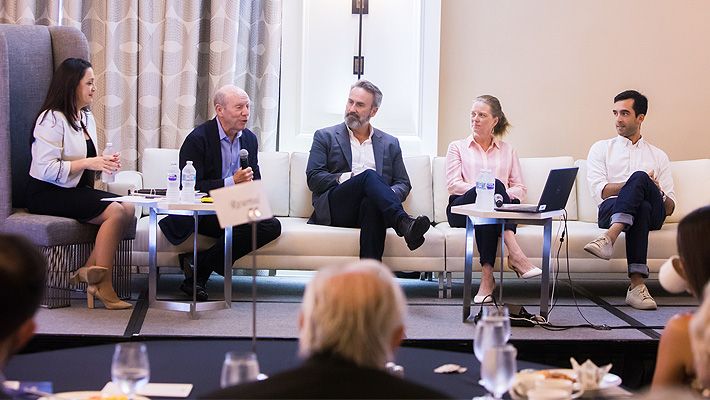By Cynthia Corzo and Ellen Forman

Miami’s Design District has evolved as a unique South Florida success story, with its mix of high-end retail, restaurants, residences, and cultural arts in a walkable environment. It is one of few neighborhoods that serves as both tourist destination and strong residential environment, maintaining an emphasis on curating unique experiences for both.
What did it take to develop and execute a real estate strategy that brings these elements together?
FIU’s Hollo School of Real Estate invited leaders of Dacra, the company founded by Craig Robins that led the Design District’s development, to share their experiences and insights with Hollo School students and alumni. The event, part of the school’s Real Estate Leadership Speaker Series, was held September 21, 2018 at the Hotel Colonnade in Coral Gables.
In a discussion moderated by Suzanne Hollander, an attorney and broker who is also a faculty member at the Hollo School, Dacra executives delivered a behind-the-scenes perspective on how the company got its start. They shared the vision of Robins, its founder, and explored the process of building the Design District into a high end shopping destination with a neighborhood feel. Robins and Dacra are also behind the development of South Beach, through the redevelopment of several Ocean Drive hotels and parts of Lincoln Road. Other Dacra projects include Aqua, the area around Alton Road and 63 St., which was originally a fill island built in the 1920s, once occupied by St. Francis Hospital, that Dacra redeveloped into a residential community.
Dacra chose to develop the Design District for its potential as a walking neighborhood, functional from a street-accessible retail component. Originally designed retail, destination restaurants came in.
In 2010, Dacra partnered with L Catterton, an international real estate fund affiliated with LVMH, transforming its turn into luxury fashion real estate.
Beginning with high-end retail, the district enabled the “branded façade,” taking the front wall as a way to incorporate brands, and providing a pedestrian walkway in the middle, with “secondary alleys” also serving as artistic focal points. The ability to provide space for retailing and branding of flagship stores allowed brands to develop a second location in Miami as the city grew its reputation as an international luxury goods destination.
Here are some of thoughts shared at the event.
“Our objective is to create great neighborhoods in Miami. When we started buying in 1994, people thought we were nuts going in there. After 2010, we had to do it very quietly because property prices would quadruple.”
“We have two goals: Be the No. 2 or No. 3 luxury shopping center in the country, and if you’re going to visit Miami, coming to the Miami Design District is a must.”
Steven Gretenstein – chief operating officer, Dacra
“We created the space and the vision for what the neighborhood was going to be. Next, we went to find tenants. Today, we have 125 tenants in the Miami Design District, and we control 70 percent of the district, unifying neighborhood streets. Common spaces are critical.”
David Holtzman – vice president, Dacra
“The focus at Miami Design District has been on rehabilitation through thoughtful development. Nobody else was doing that. Craig (Robins) is known for doing things out of the box. He takes risks, like giving an artist an alley and telling him to make it real.”
“Art is a gathering place that activates street traffic. For example, a sculpture was inserted into the Moore building, and that’s something that connects the past to the present.
Tiffany Chestler – director of cultural programming, Dacra; art curator for the Robins Collection
“We’re promoting it as a neighborhood not just for tourists, but for locals as well. The Miami Design District’s brand identity: cultural hub. Art tours, concerts–all this brings people into the neighborhood.”
Teddy Shriver – marketing director, Miami Design District
“Public art projects are part of the neighborhood. We’re creating experiences to get you away from your computer and come in. Miami Design District is a fully integrated neighborhood – you can live, work, play, visit – cultural programming is a big part of our DNA. We’re giving people reasons to come into the neighborhood.”
“What’s next? We’re not going to repeat Miami Design District. We’ve never replicated a neighborhood.
Steven Gretenstein





